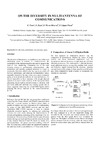Please use this identifier to cite or link to this item:
https://accedacris.ulpgc.es/jspui/handle/10553/42968
| DC Field | Value | Language |
|---|---|---|
| dc.contributor.author | Peco, C. | en_US |
| dc.contributor.author | Zazo, S. | en_US |
| dc.contributor.author | Pérez-Álvarez, I. | en_US |
| dc.contributor.author | López-Pérez, J. | en_US |
| dc.date.accessioned | 2018-11-21T11:53:31Z | - |
| dc.date.available | 2018-11-21T11:53:31Z | - |
| dc.date.issued | 2009 | en_US |
| dc.identifier.isbn | 9781849191234 | en_US |
| dc.identifier.uri | https://accedacris.ulpgc.es/handle/10553/42968 | - |
| dc.description.abstract | The objective of this paper is to contribute to one of the most challenging issues in modern HF communications: the exploitation of the multiantenna diversity and its impact in the need of time interleaving. Comparing two of the main diversity sources in multiantenna communications (the polarization and spatially separated antennas) we expect to empirically determine which is the best option as a trade off between performance and practical implementation issues, especially focused in the case where strict space constraints apply, as in naval and air platforms. In such applications, it is almost impossible to have antennas with enough physical separation to exploit some diversity. If the dual polarization processing proves itself as a reliable source of diversity, with just some additional hardware any existing system can be easily upgraded, improving the overall BER figures and/or reducing the delays imposed by the coders/interleavers. [1,2,3]. | |
| dc.language | spa | en_US |
| dc.relation.ispartof | IET Conference Publications | en_US |
| dc.source | IET Conference Publications,v. 2009, p. 61-64 | en_US |
| dc.subject | 3307 Tecnología electrónica | en_US |
| dc.title | On the diversity in multiantenna HF communications | en_US |
| dc.type | info:eu-repo/semantics/conferenceObject | es |
| dc.type | ConferenceObject | es |
| dc.relation.conference | IET 11th International Conference on Ionospheric Radio Systems and Techniques, IRST 2009 | |
| dc.identifier.doi | 10.1049/cp.2009.0035 | |
| dc.identifier.scopus | 79953014407 | - |
| dc.contributor.authorscopusid | 37051089000 | - |
| dc.contributor.authorscopusid | 6701549562 | - |
| dc.contributor.authorscopusid | 6603181795 | - |
| dc.contributor.authorscopusid | 15757650500 | - |
| dc.description.lastpage | 64 | - |
| dc.description.firstpage | 61 | - |
| dc.relation.volume | 2009 | - |
| dc.investigacion | Ingeniería y Arquitectura | en_US |
| dc.type2 | Actas de congresos | en_US |
| dc.date.coverdate | Diciembre 2009 | |
| dc.identifier.conferenceid | events121399 | |
| dc.identifier.ulpgc | Sí | es |
| item.grantfulltext | open | - |
| item.fulltext | Con texto completo | - |
| crisitem.author.dept | GIR IDeTIC: División de Ingeniería de Comunicaciones | - |
| crisitem.author.dept | IU para el Desarrollo Tecnológico y la Innovación | - |
| crisitem.author.dept | GIR IDeTIC: División de Ingeniería de Comunicaciones | - |
| crisitem.author.dept | IU para el Desarrollo Tecnológico y la Innovación | - |
| crisitem.author.orcid | 0000-0001-5990-8409 | - |
| crisitem.author.parentorg | IU para el Desarrollo Tecnológico y la Innovación | - |
| crisitem.author.parentorg | IU para el Desarrollo Tecnológico y la Innovación | - |
| crisitem.author.fullName | Pérez Álvarez,Iván Alejandro | - |
| crisitem.author.fullName | López Pérez,Javier | - |
| crisitem.event.eventsstartdate | 28-04-2009 | - |
| crisitem.event.eventsenddate | 30-04-2009 | - |
| Appears in Collections: | Actas de congresos | |
SCOPUSTM
Citations
4
checked on Jun 8, 2025
Page view(s)
90
checked on Jul 6, 2024
Download(s)
237
checked on Jul 6, 2024
Google ScholarTM
Check
Altmetric
Share
Export metadata
Items in accedaCRIS are protected by copyright, with all rights reserved, unless otherwise indicated.
